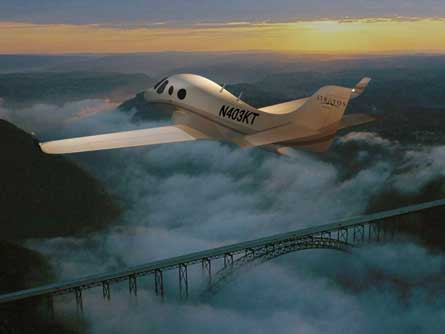Kate Sarsfield/London
Stratos Aircraft is gearing up to begin wind-tunnel testing of a 1/5th scale model of its 714 "very light personal jet", and is seeking to secure the next tranche of investment to fund the single-engine, high-performance aircraft through first flight.
"We managed to secure a slice of funding last year that will fund the wind testing and the production and testing of the main structural parts, which will begin later this year," said Carsten Sundin, Stratos's chief technical officer. He admitted the climate for attracting fresh funding for aircraft programmes remains weak. "We have secured just under half the funding needed [to bring the aircraft to market] It is a real challenge. But we are starting see interest in our project from potential investors who are looking for compelling business model."
Sundin said the five-seat 714 is being developed with minimal overheads in an effort to keep costs as low as possible. He said: "We will outsource as much of the manufacturing as we can. There is little point building composite parts yourself as the start-up costs for engineers and tooling, for example, are huge, and add to our overheads at a time when every dollar counts. We do, however, plan to do the final assembly ourselves at our facility in Bend, Oregon."
 |
|---|
© Stratos Aircraft |
Stratos aims to produce between 20 and 50 714s per year |
Sundin said the Stratos business model is "entirely realistic". "We are not telling potential investors that we are going to produce thousands of aircraft year as these number cannot be sustained, given the cyclical nature of this business," he said. Stratos is aiming for production of between 20 to 50 aircraft a year. "At 20 a year we will still be able to keep the lights on and at 50 we will be making a good profit," he said.
Wind-tunnel testing will start on 8 August at the University of Washington in Seattle and is expected to last for four days. Stratos said its engineering team expects to collect data on drag, lift, stability derivatives, downwash angles, ground effect, and flow visualisation to check for separation. A number of pressure ports in the model will be used to measure local pressures in key areas. While this may precipitate some redesign in fuselage, wing or tail configuration, the team is not anticipating any significant changes.
Stratos has now secured five orders for the $2 million Williams FJ-44-3AP-powered aircraft, which is pitched against the Diamond D-Jet, the Piper Altaire and the Cirrus SF50 Vision. It has a projected cruise speed of 400kt (740km/h) and a range of 1,500nm (2,775km). The company expects to have two flying prototypes within two years. "If we were fully funded we would anticipate certification and service entry to be three to four years away. We are hopeful that this will be so," said Sundin.
Source: Flight International























